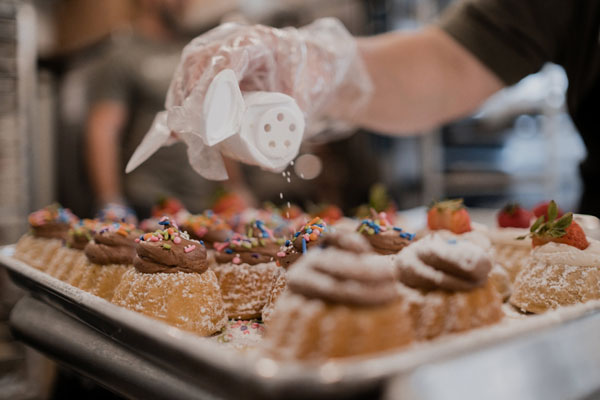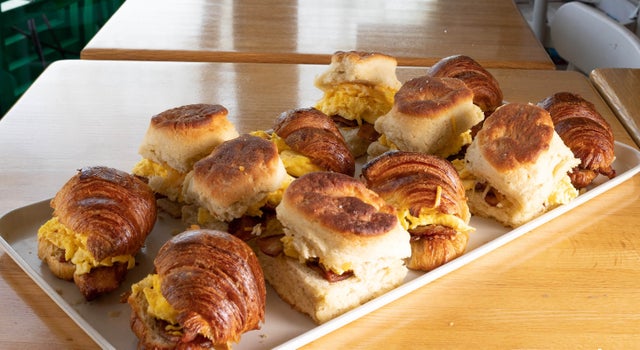Premier Bakery Catering Maddington for Flavorful Treats
Premier Bakery Catering Maddington for Flavorful Treats
Blog Article
Recognizing the Art of Bakeshop Products: From Newly Baked Breads to Tempting Pastries and Finger Foods
From the science behind the perfect loaf of bread, where fermentation and gluten development play critical duties, to the finesse needed for creating split pastries, each facet exposes a compelling narrative of craftsmanship. The convenience of finger foods highlights how flavor and texture can be artfully combined to involve diverse preference choices.
The Science of Bread Making
At the heart of every loaf of bread lies a remarkable interaction of chemistry and biology. The procedure of bread making starts with the combination of flour, water, yeast, and salt-- each component playing a critical role in the final product. Flour contains healthy proteins, primarily glutenin and gliadin, which, when blended with water, kind gluten (Catering Maddington). This elastic network is essential for trapping gases produced during fermentation.
Yeast, a living organism, ferments the sugars existing in the flour, creating co2 and alcohol while doing so. The co2 gas develops bubbles in the dough, creating it to increase and create a light texture. The temperature and humidity during fermentation considerably affect yeast activity and, as a result, the bread's flavor and texture.

Mastering Pastry Methods
Exactly how can one achieve the delicate balance of texture and flavor that specifies extraordinary bread? Grasping bread strategies calls for a deep understanding of active ingredients, techniques, and the scientific research behind them. Basic to this craft is the selection of top quality ingredients-- flour, butter, sugar, and eggs-- each playing an important role in the end product's flavor and texture.
The technique of lamination, which involves folding layers of dough and butter, develops the desired flakiness in breads like croissants and smoke pastry. Accuracy in temperature is essential, as butter needs to continue to be cold to make certain ideal layers. Correct mixing techniques, such as the creaming technique for cakes, make certain also incorporation of air and fat, resulting in a light and airy crumb.
Additionally, preserving the best moisture levels during baking can significantly affect the outcome, ensuring that breads increase properly and accomplish that golden-brown finish. Lastly, the art of pastry also requires patience and practice; each attempt improves one's skill and understanding of the detailed balance needed to develop alluring pastries that thrill the detects. Proficiency in these strategies eventually differentiates a competent bread chef from an amateur.
Types of Finger Foods
The world of cooking thrills prolongs past breads to encompass a large array of finger foods, which are celebrated for their benefit and convenience. These bite-sized deals with are excellent for social events, using a variety of tastes and structures that accommodate varied palates.

On the sweeter side, bite-sized cupcakes and mini tarts offer a fascinating surface to any kind of dish, attracting those with a pleasant tooth. Cheese and charcuterie boards serve as an advanced option, allowing visitors to personalize their bites with an assortment of meats, fruits, nuts, and cheeses.
Flavor Profiles in Baking
Baking is a detailed dancing of flavor profiles that incorporates pleasant, savory, and umami notes to create an unified experience for the taste. Comprehending these profiles is important for bakers seeking to elevate their productions.
Sweetness commonly works as the foundation in baked items, with sugars, fruits, and natural sugar boosting flavor depth. Components such as chocolate and caramel present intricate sweet notes that can either control or enhance other tastes. On the other hand, tasty aspects, usually found in breads and breads, supply equilibrium and contrast. Components like herbs, cheeses, and flavors can transform an easy dough right into a complex taste experience.
Umami, regularly ignored in cooking, plays a considerable duty in improving tastes. Active ingredients such as aged cheeses, fermented items, or perhaps certain nuts add to a full-flavored depth that boosts overall preference.
Additionally, the interplay of level of acidity from ingredients like buttermilk or citrus zest can lighten up flavors, offering a refreshing counterpoint to sweetness. By thoughtfully combining these taste accounts, bakers can craft items that resonate with varied tastes, developing a memorable culinary experience. Ultimately, grasping taste profiles is essential to innovation on the planet of baking.
Vital Baking Equipments and Ingredients
Understanding taste profiles in cooking sets the phase for picking the right devices and ingredients that promote the development of phenomenal baked goods. A dependable set of cooking pans-- such as sheet frying pans, loaf frying pans, and cake frying pans-- is vital for attaining preferred shapes and appearances.
In regards to ingredients, top quality issues considerably. Flour functions as the backbone of many recipes; picking the appropriate kind-- be it all-purpose, bread, or pastry flour-- can considerably affect the end result. Sugar not only this post sweetens however additionally adds to texture, while eggs work as binders and raising agents. Cooking powder and baking soft drink are necessary for developing lift in cakes and pastries.
Furthermore, integrating taste enhancers like vanilla remove, spices, and citrus zest can raise your productions. By ensuring access to these fundamental devices and active ingredients, bakers can confidently start their culinary journey, crafting a varied selection of wonderful baked items.
Verdict
Proficiency in bread production, bread prep work, and finger food discussion exposes the intricate relationships in between components and procedures. Birthday Catering Maddington. Exploring varied flavor profiles enhances the baking experience, while crucial devices and components supply the structure for success.
Exactly how can one achieve the delicate equilibrium of structure and taste that specifies outstanding bread? Essential to this craft is the choice of premium active ingredients-- flour, butter, sugar, and eggs-- each playing an important function in the final item's flavor and structure.

Understanding flavor accounts in baking collections the stage for choosing the right devices and active ingredients that assist in the development of exceptional baked goods. Discovering varied blog flavor accounts enhances the baking experience, while necessary devices and components give the structure for success.
Report this page